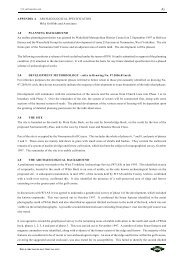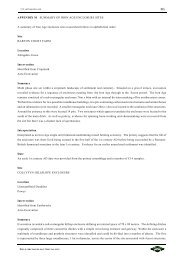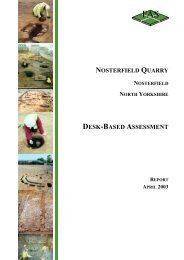ARCHAEOLOGICAL EVALUATION - Mike Griffiths and Associates
ARCHAEOLOGICAL EVALUATION - Mike Griffiths and Associates
ARCHAEOLOGICAL EVALUATION - Mike Griffiths and Associates
You also want an ePaper? Increase the reach of your titles
YUMPU automatically turns print PDFs into web optimized ePapers that Google loves.
FAS_lbf01.wpd 59<br />
resistance <strong>and</strong> one of high resistance were identified <strong>and</strong> interpreted as variation in the natural subsoil.<br />
F39<br />
This is an amorphous low resistance anomaly measuring approximately 5.20m x 4.0m. The anomaly<br />
may represent a pit or sink hole.<br />
F40<br />
This is a possible rectilinear low resistance anomaly orientated NNE-SSW <strong>and</strong> NNW-SSE measuring<br />
34.80m <strong>and</strong> 16.50m respectively. The anomaly may represent a field enclosure or field drain.<br />
F41<br />
This is a sub-oval high resistance anomaly measuring approximately 34.80m x 16.5m in diameter. The<br />
anomaly may represent local variation in the underlying natural subsoil.<br />
F42<br />
This is an amorphous low resistance anomaly measuring approximately 12.50m x 5.60m. The anomaly<br />
may represent a pit, sink hole, or variation in the local geology.<br />
F43<br />
This is a group of three small circular low resistance anomalies orientated NW-SE measuring 1.50m,<br />
2.00m, <strong>and</strong> 1.75m in diameter. The anomalies may represent pits or sink holes.<br />
F44<br />
This is a group of two large circular low resistance anomalies measuring 4.00m <strong>and</strong> 5.50m in diameter<br />
situated 4.30m to the southwest of F43. The anomalies may represent pits or sink holes.<br />
The soil resistance pilot study detected possible field enclosures, isolated anomalies <strong>and</strong> other possible features.<br />
The results of the pilot study indicated that soil resistance may prove to be a more reliable method of detecting<br />
a broader range of sub-surface features. As such, a soil resistance area survey was employed to investigate<br />
Zone D, which had become available for study, having not been accessible during the magnetometer area survey.<br />
6.3.2 Soil Resistance Area Survey<br />
A cruciform-shaped sample area was designed to target possible linear features in the zone. The survey area<br />
consisted of two linear areas which crossed one another. These measured 30.0m x 330.0m north-south <strong>and</strong><br />
30.0m x 300.0m east-west. The results from the 0.5m <strong>and</strong> the 1.0m probe separation survey results are presented<br />
in Figures 31 <strong>and</strong> 32, <strong>and</strong> the interpretation of the survey results is presented in Figure 33.<br />
Only two potentially archaeological anomalies were identified within area D1 <strong>and</strong> were allocated F45 <strong>and</strong> F46.<br />
Several high resistance anomalies have been identified, as well as broader areas of high <strong>and</strong> low resistance<br />
throughout D1; all of these areas are considered to relate to variation in the local geology.<br />
F45<br />
This is a circular low resistance anomaly measuring approximately 7.50m in diameter <strong>and</strong> disappears<br />
beyond the northern limit of D1. The anomaly may represent a pit or sink hole.<br />
F46<br />
This is a possibly linear ‘Y’-shaped low resistance anomaly visible for the width of area D1 at this point<br />
(30.0m), orientated approximately east-west <strong>and</strong> measures no more than 4.20m wide. The linear<br />
anomaly splays towards the east to form two spurs. The feature may represent a field boundary or field<br />
drains, or possibly geological variation. The improved definition of this feature on the 1.0m probe<br />
FIELD ARCHAEOLOGY SPECIALISTS







